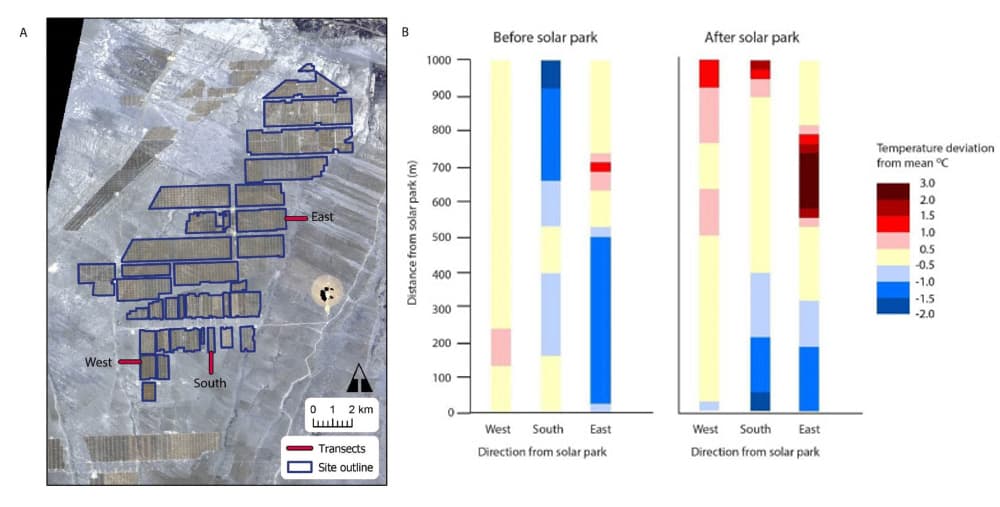
[Image above] The impact of solar parks on land surface temperature at Longyangxia Solar Park in Qinghai Province, China. Credit: Guoqing et al., Renewable and Sustainable Energy Transition (CC BY 4.0)
As average temperatures around the world continue creeping higher, the heat island effect is becoming an increasingly worrisome phenomenon for people living in big cities.
A heat island refers to an area that is significantly warmer than its surroundings. This heat is due largely to urban development that replaces vegetation with asphalt and concrete, materials that absorb rather than reflect the sun’s heat. This absorption—plus the reduction of air flow by tall buildings and narrow streets—leads to rising temperatures that exacerbate the impact of naturally occurring heat waves.
Relying on air conditioning to combat the heat is an expensive and often polluting solution. Instead, researchers are investigating alternative cooling solutions, such as developing highly heat-reflective coatings for roofs and walls, and embracing materials other than concrete for construction.
Combatting the heat does not necessarily require implementing all-new solutions, however. In a recent open-access article, researchers led by Lancaster University in the United Kingdom suggest that solar parks may have the unintended effect of combatting the heat as well.
Solar energy is becoming an increasingly significant component of the United States energy sector. In the last decade alone, solar experienced an average annual growth rate of 42%, and there are now more than 100 gigawatts of solar capacity installed nationwide, according to a report on the Solar Energy Industries Association website.
Despite this growth, many questions remain about the impacts of solar parks on the surrounding environment. Studies on solar parks co-located with agriculture (agrivoltaics) and on manmade reservoirs (floatovoltaics) indicate potential benefits to the environment, but there is still much to learn about the effects.
In the recent paper, the Lancaster researchers along with colleagues from Ludong University in China and the University of California, Davis indicate that their research is partially inspired by what is known about the environmental impacts of wind farms.
“Moreover, evidence indicates that wind farms alter the microclimate within and outside site boundaries with implications for ecosystem processes, including crop growth,” they write. “Emerging understanding of the climatic impacts of [land use and land cover change] for solar parks evidences altered air and surface temperatures to magnitudes known to impact ecosystem processes” as well; however, “current knowledge is less developed than that for wind farms.”
The researchers explain that satellite data offers an “unexplored robust means” of quantifying the impact of solar parks on the environment. Specifically, “The existence of imagery both before and after solar park construction is a considerable advantage over field studies which are commonly stymied by the lack of pre-construction data,” they write.
For their study, they investigated the possible effect of two ground-mounted, large-scale, fixed-axis photovoltaic solar parks in China and the United States on surface temperature of the surrounding land. They derived the temperature using satellite data from Landsat, a joint NASA/U.S. Geological Survey program.
By comparing data from before and after solar park construction, the researchers found the parks produced cool island effects extending around 700 meters (a little under half a mile) from the solar park boundaries. Specifically, at 100 meters away, the temperature of the surrounding land surface was reduced by up to 2.3℃.

Details of the land surface temperature calculation using the Google Earth Engine Toolbox, which uses a method outlined in Giannini et al. and uses an emissivity method from Sobrino et al. Credit: Guoqing et al., Renewable and Sustainable Energy Transition (CC BY 4.0)
In a Lancaster press release, Lancaster senior lecturer in energy and environmental sciences Alona Armstrong explains that this finding highlights important considerations for future solar park construction.
“Most studies examine the impacts of land use change for solar parks inside the site boundaries. … [Our study] heightens the importance of understanding the implications of renewable energy technologies on the hosting landscape—we need to ensure that the energy transition does not cause undue damage to ecological systems and ideally has net positive consequences on the places where we build them,” she says.
Further studies are needed to confirm the mechanisms behind the cool island effect. However, the researchers suggest that solar array shading and insulating of the land surface, as well as energy being converted into electricity by the solar panels, could be possible causes.
The open-access paper, published in Renewable and Sustainable Energy Transition, is “Ground-mounted photovoltaic solar parks promote land surface cool islands in arid ecosystems” (DOI: 10.1016/j.rset.2021.100008).
Author
Lisa McDonald
CTT Categories
- Energy
- Environment


